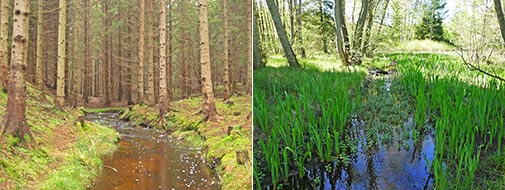Ecological restoration

Ecological restoration is “the process of assisting the recovery of an ecosystem that has been degraded, damaged or destroyed”. A further explanation of this definition can be found in the Primer on Ecological Restoration from the international Society for Ecological Restoration.
Reference ecosystem
An important concept in ecological restoration is to compare the result with the status of intact ecosystems, and to accept behaviours and features of intact ecosystems, such as complexity and unpredictable changes. Intactness can be linked with the degree of human influence on ecosystems, where the degraded ecosystem might have little intactness, but where the restored ecosystem again can achieve high naturalness if complexity and unpredictable changes are accepted. Following this, an open-ended approach to restoration might be desirable, and is implemented in the restoration of Øle Å. The open-ended approach does not aim at obtaining specific habitats and ecological structures and processes but seeks to stimulate natural processes with little or no human influence. This approach stands in contrast to efforts aiming at obtaining very specific habitats and desired species.
Successful river restoration
Five criteria for measuring successful river restoration, with emphasis on the ecological perspective, were proposed by Margaret Palmer et al, and are incorporated in the restoration of Øle Å:
- The design of an ecological river restoration project should be based on a specified guiding image of a more dynamic, healthy river that could exist at the site.
- The river’s ecological conditions must be measurably improved.
- The restored river system must be more self-sustaining and resilient to external perturbations such that only minimal follow-up maintenance is needed.
- During the construction phase, no lasting harm should be inflicted on the ecosystem.
- Both pre- and post-assessment must be completed and data made publicly available.
International recognition
Ecological restoration has internationally been recognized as a critical contribution to management of the World’s ecosystems as seen in UN conventions such as the Convention on Biological Diversity (CBD), the Convention to Combat Desertification (UNCCD) and the UN Framework Convention on Climate Change (UNFCCC). This is also evident in the CBD Strategic Plan for Biodiversity 2011-2020 and the Aichi Biodiversity Targets, in which two out of twenty targets aim at restoring degraded ecosystems, read it here.
